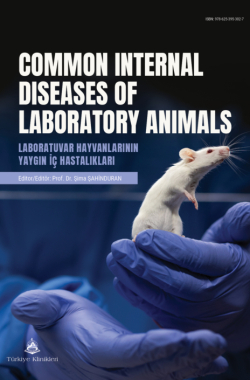Nutrition of Laboratory Animals
Sesil EFECANa , Süleyman ŞENSOYb
aBurdur Mehmet Akif Ersoy University Burdur Food Agriculture and Livestock Vocational School, Department of Animal Nutrition and Nutritional Diseases, Burdur, Türkiye
bBurdur Mehmet Akif Ersoy University Burdur Food Agriculture and Livestock Vocational School, Department of Internal Medicine, Burdur, Türkiye
Efecan S, Şensoy S. Nutrition of laboratory animals. In: Şahinduran Ş, ed. Common Internal Diseases of Laboratory Animals. 1st ed. Ankara: Türkiye Klinikleri; 2024. p.17-21.
ABSTRACT
In biological in vivo experiments, small laboratory animals such as mice, rats, gerbils, hamsters, guinea pigs, and rabbits are commonly used alongside cats and dogs. The preference for these rodents stems from their small size, ease of maintenance and care, and their ability to adapt easily to new environments. Additionally, they reproduce rapidly and complete their lifespan in a short period, typically two to three years. This rapid reproduction allows for relatively quick generations of rodents. Ensuring the success of experiments requires not only meeting the necessary conditions for the care and management of experimental animals but also ensuring that they are well cared for and nourished.
Keywords: Nutrition; laboratory animals; mouse; rat; gerbil
Kaynak Göster
Referanslar
- National Research Council. Nutrient Requirements of Laboratory Animals. 4th revised ed. Washington DC: National Academy Press; 1995.
- Poyraz Ö. Laboratuvar Hayvanları Bilimi. Ankara: Kardelen Ofset; 2000. p. 198-9.
- Güney Saruhan B, Dereli S. Deney Hayvanlarının Beslenme, Barındırma ve Üremesi. Dicle Üniv Vet Fak Derg. 2016;1(3):16-21.
- Ritskes-Ritskes-Hoitinga M, Tobin G, Jensen TL, Mikkelsen LF. Nutrition of the laboratory mouse. In: Hedrich H, ed. The Laboratory Mouse. 2nd ed. Amsterdam: Elsevier Ltd; 2012. p.567-99. [Crossref]
- Council of Europe. Resolution on the Accommodation and Care of Laboratory Animals. 1997.
- İde T. Laboratuvar Hayvanları Biliminin Temel İlkeleri. 1. Baskı. Ankara: Medipres Yayınları; 2003.
- Kirkwood J, Hubrecht RC. The UFAW Handbook on the Care and Management of Laboratory and Other Research Animals. 8th ed. Chichester: John Wiley & Sons; 2010. [Crossref]
- Fajardo G, Hörnicke, H. Problems in estimating the extent of coprophagy in the rat. Br J Nutr. 1989;62(3):551-61. [Crossref] [PubMed]
- Galef Jr BG. Social learning of food preferences in rodents: rapid appetitive learning. Curr Protoc Neurosci. 2002;21(1):8-5. [Crossref] [PubMed]
- Geçmez K, Akkoyun HT, Kızıl M, Bayramoğlu Akkoyun M. (2023).Some anatomical, physiological, and reproductive characteristics of laboratory animals rat, guinea pig, and rabbit. J Lab Anim Sci and Prac. 2023;3(1):22-7. [Crossref]
- Goto S, Takahashi R, Radak Z, Benefi cial biochemical outcomes of lateonset dietary restriction in rodents. Ann N Y Acad Sci. 2007;1100:431-41. [Crossref] [PubMed]
- Suckow MA, Weisbroth SH, Franklin CL. The Laboratory Rat. Elsevier; 2015.
- Köksal BH. Arkadaş hayvanların ve zoolojik türlerin beslenmesi. Alp M, Kocabağlı N, editörler. Çiftlik Hayvanlarının Yemleri ve Beslenmesi. 6. Baskı. Ankara: Nobel Akademik Yayıncılık; 2016. p.476.
- Ergün A, Tuncer ŞD, Çolpan İ, Yalçın S, Yıldız G, Küçükersan MK, ve ark. Laboratuvar hayvanlarının beslenmesi. Hayvan Besleme ve Beslenme Hastalıkları. 6. Baskı. Ankara: Ankara Üniversitesi Veteriner Fakültesi; 2014. p.709.
- Carpenter jW, Wolf KN, Kolmsetter C. Feeding small pet mammals. In: Hand MS, Thatcher CD, Remillard RL, Roudebush P, Novotny BJ, eds. Small Animal Clinical Nutrition. 5th ed. Topeka, Kan.: Mark Morris Institute; 2010. p.1232-3.
- Harkness JE, VandeWoude S, Turner PV, Wheler CL. Harkness and Wagner's biology and medicine of rabbits and rodents. Biology and Husbandry (Chapter 2). 5th ed. Blackwell Publishing; 2010. p. 74-83.
- Salman M. Deney Hayvanlarının beslenmesi. Aksoy A, Kolbakır F, Hökelek M, editörler. Laboratuvar Hayvanları. 1. Baskı. Yayın no 132, Samsun: Ondokuz Mayıs Üniversitesi Yayınları; 2010. p.285-303.
- Beynen AC, Coates ME. Nutrition and experimental results. In: Zutphen LFM, Baumans V, Beynen AC, eds. Principles of Laboratory Animal Science. 2nd ed. Amsterdam: Elseiver Science BV; 2003. p.111-27.
- Clemons DJ, Seeman JL. The laboratory guinea pig. A Volume in the Laboratory Animal Pocket reference series. 2nd ed. Boca Raton: CRC Press; 2011.
- Garner-Richardson V. Guinea pig nutrition. The Veterinary Nurse. 2012;3(5):274-83. [Crossref]
- Yıldız G. Laboratuvar hayvanlarının beslenmesi, fare, rat, hamster, kobay, gerbil ve şinşilla besleme. Ergün A, Tuncer ŞD, Çolpan İ, Yalçın S, Yıldız G, Küçükersan MK, editörler. Hayvan Besleme ve Beslenme Hastalıkları. 7. Baskı. Ankara: Kardelen Ofset Ltd. Şti; 2017. p.705-17.
- Smith AC. The raising and Care of Guinea Pigs-A Complete Guide to the Breeding Feeding, Housing, Exhibiting and Marketing of Cavies. Missouri: Project Gutenberg; 2010.
- Manning PJ, Ringler DH, Newcomer CE. The Biology of the Laboratory Rabbit. 2nd ed. New York: Academic Press; 2014. p 321.
- Pond WG, Church DB, Pond KR, Schoknecht PA. Basic Animal Nutrition and Feeding. John Wiley & Sons; 2004.
- Suckow MA, Schroeder V, Douglas FA. The Laboratory Rabbit. 2nd ed. Boca Raton: CRC Press; 2010. p. 11-25. [Crossref]
- Cunha TJ, Cheeke PR. Rabbit Feeding and Nutrition. 1st ed. New York: Academic Press Inc; 1987. p. 1-197.

